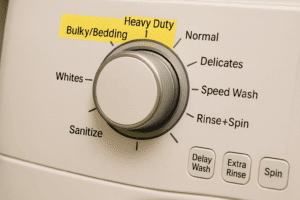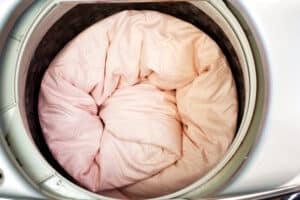Heavy Duty vs Bulky Items Washer Cycle
Chicago laundry day often brings a common question: should you use the heavy duty or bulky items cycle on your washer? If you’ve puzzled over that dial while staring at a heap of clothes, you’re not alone. The average U.S. household runs around 7–8 loads of laundry per week, so picking the right setting isn’t just trivia – it can make laundry easier and help your clothes last longer. As a Chicago-owned, clean-obsessed laundry service, we’re here to explain in plain language the difference between the heavy duty and bulky cycles and when to use each.
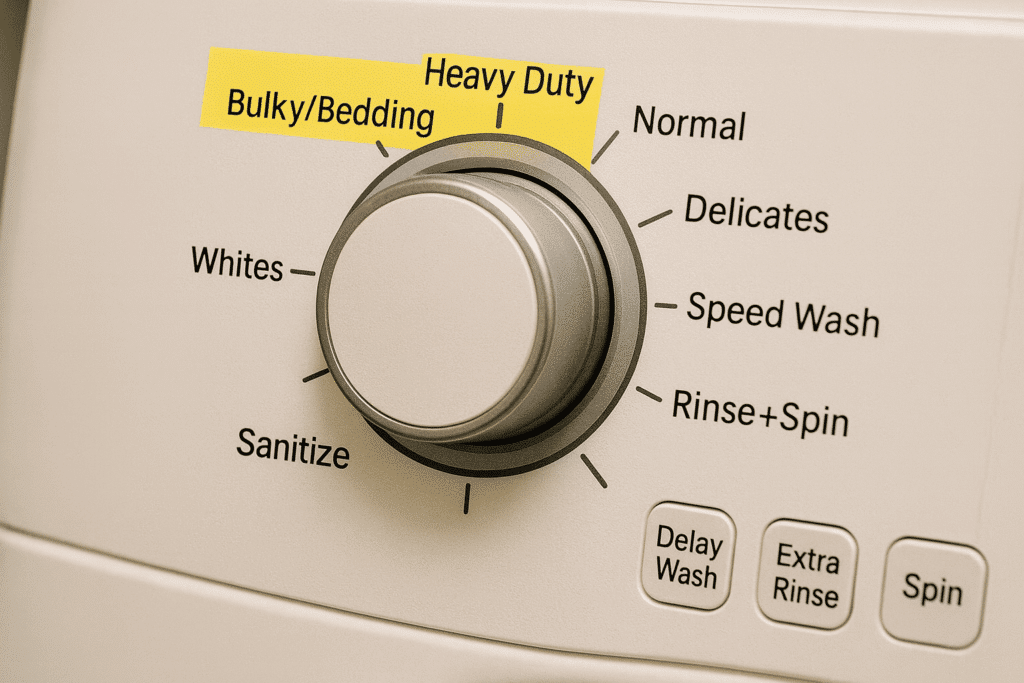
Heavy duty vs bulky items washer cycles: what’s the difference?
Both “Heavy Duty” and “Bulky Items” cycles are designed for big jobs, but they serve different purposes. In short, the heavy duty cycle is all about intense cleaning for sturdy, dirty items, while the bulky cycle is meant to gently handle large, voluminous items. Heavy duty uses a longer wash time, stronger agitation, and often higher heat to scrub out deep dirt and stains. Bulky cycles, on the other hand, typically use extra water with a gentler rocking motion and a slower spin to accommodate things like bedding that absorb lots of water. The result? Heavy duty focuses on heavy soil, and bulky focuses on heavy size.
Think of it this way: the heavy duty setting tackles grime and grit in tough fabrics, and the bulky setting ensures big items get thoroughly soaked and cleaned without wrecking either the item or your washer. They can overlap sometimes – for example, a large dirty blanket might need thorough cleaning and extra water – but the cycles aren’t identical. Up next, we’ll break down each setting in plain terms and when to choose one over the other.
What is the heavy duty cycle?
The heavy duty cycle on a washing machine is a long, intensive wash program designed for heavily soiled or durable items. In everyday terms, this is the setting you pick for things like muddy work jeans, sweaty gym towels, or a load of bath towels that need a deep clean. Heavy duty cycles typically use hotter water, a longer wash time, and high-speed agitation and spin. That means the washer will vigorously scrub the clothes and spin them fast to wring out as much water as possible. Manufacturers often recommend heavy duty for sturdy fabrics like towels and jeans, and with good reason. This cycle isn’t gentle, but it gets the dirt out and can even help remove odors from deeply grubby items. Just keep in mind that if your clothes aren’t that dirty, using heavy duty is overkill – you’d be wasting time and water for an everyday load.
What is the bulky items cycle?
The bulky (or “Bulky/Bedding”) cycle is designed for big, puffy or dense items that need extra water to get fully clean. In plain language, choose this setting for things that take up a lot of space in the drum – like comforters, pillows, sleeping bags, heavy winter jackets, or a big batch of bed sheets. The bulky cycle usually starts by adding a lot of water to completely soak your items. It then uses a slow, gentle agitation (the drum rocks back and forth more mildly) so those bulky pieces swish around without tangling or stretching. The spin speed is often slower or medium on bulky cycles, which helps prevent your washer from shaking like crazy with an unbalanced load. As laundry experts note, bulky cycles use more water and a moderate spin to ensure thick items like pillows and comforters get rinsed and cleaned throughout without getting flattened. In short, the bulky setting pampers your oversize items – it’s not about scrubbing out heavy stains (you have heavy duty for that), but about thoroughly soaking and rinsing large items.
When to use heavy duty vs bulky for common laundry items
So which cycle should you choose for your everyday laundry challenges? Here’s a friendly guide to using heavy duty versus bulky for typical items in a Chicago household. Knowing when to use each will help you avoid washed-out colors, leftover grime, or even damage to your stuff.
Towels, jeans, and work clothes: heavy duty
Sturdy fabrics and dirty loads: Towels, denim jeans, and rugged work clothes are prime candidates for the heavy duty cycle. These items can withstand the washer’s vigorous scrubbing and they often need it – for example, bath towels build up body oils and odors, and heavy duty’s hot water and longer wash help get them truly fresh. Likewise, a load of jeans or canvas uniforms with dirt and sweat will benefit from the extra agitation. Using heavy duty here means you’re leveraging maximum cleaning power. You’ll likely see better results than a normal cycle, especially if the clothes are heavily soiled. Just be mindful not to mix delicate items in these loads. If you’re washing a mixed load (say, jeans and t-shirts), consider whether the whole load really needs heavy duty treatment; otherwise stick to a normal cycle for the lighter items.
Pro tip: If your laundry pile regularly includes greasy coveralls or mud-caked sports gear, heavy duty will be your best friend. For particularly stubborn stains, you can even pre-soak or select an extra rinse to help out. And if you feel like those tough loads are eating up your week, remember you can always let our wash-and-fold service handle the grime. We’ll return your work clothes and towels fresh, clean, and even ozone-sanitized, with drawer-ready folds – no extra effort on your part.
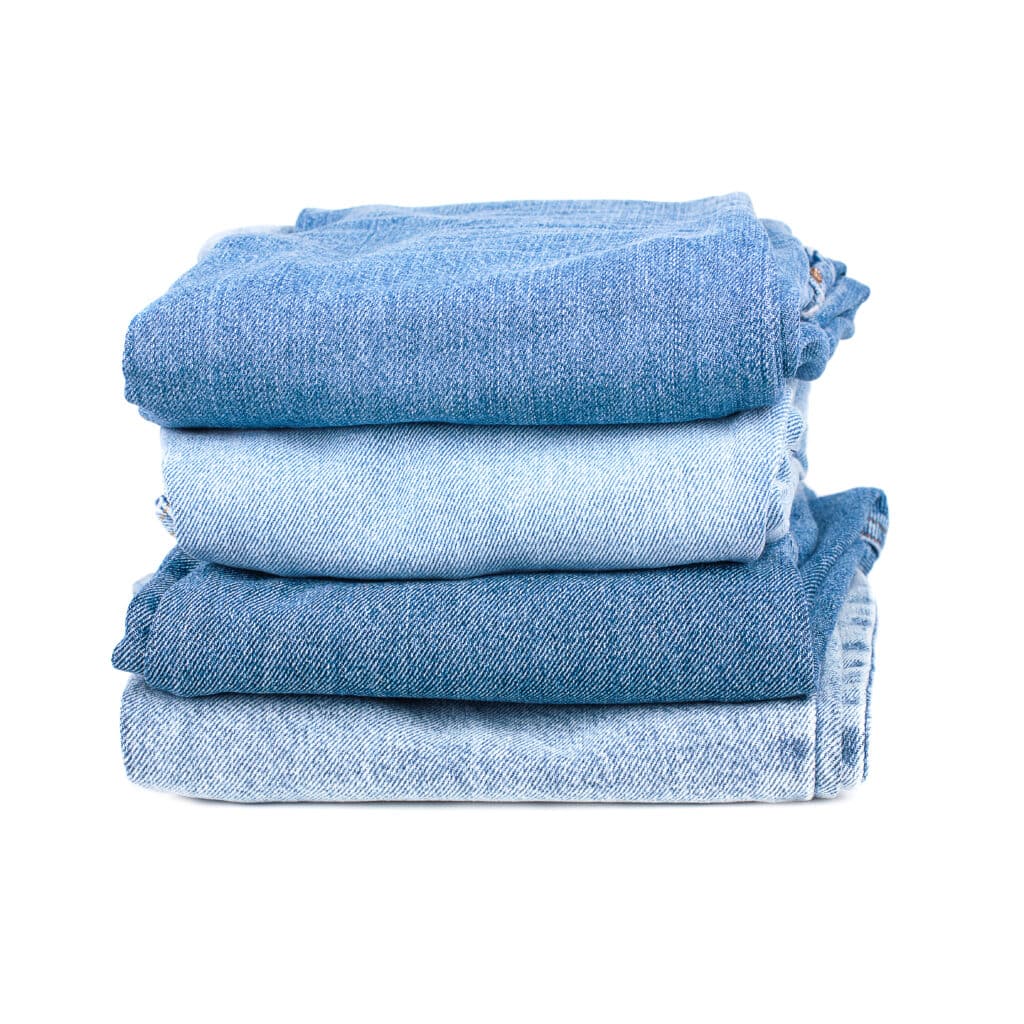
Bedding and blankets: bulky cycle
Large linens and bedding: When laundry day includes washing the bedding – like that king-size comforter, puffy duvet, or a pile of blankets – reach for the bulky cycle. A common question we hear is, “heavy duty vs bulky for bedding – which do I use?” In almost all cases, bulky is the way to go for bed linens and large blankets. These items are physically large and can quickly overload a normal cycle. The bulky setting fills the tub high with water to soak through thick layers of fabric (imagine trying to wash a comforter with just a small amount of water – the inside would stay dry and dirty). The gentler agitation also prevents sheets or blankets from twisting into a tight ball, which is a common issue if you use the wrong cycle. And by spinning at a lower speed, the washer avoids shaking the whole house when your comforter clumps to one side.
Keep in mind capacity: Bulky cycles help, but even they have limits. If your comforter is too large for your home machine (or weighs a ton when wet), don’t force it – that’s a quick way to strain your washer. Instead, you can bring big items to one of our self-service laundry locations, where we have high-capacity machines made for bulky loads. We’ve seen Chicago neighbors wrestling with oversized bedding, and we’re happy to provide washers that take the hassle out of that chore. Toss in your queen or king comforter at our place, use the bulky cycle, and let those large drums do the work. (And if you prefer to skip the trip altogether, our pick-up and delivery team can collect your bedding and return it freshly washed – no more stuffing a comforter into your car!)
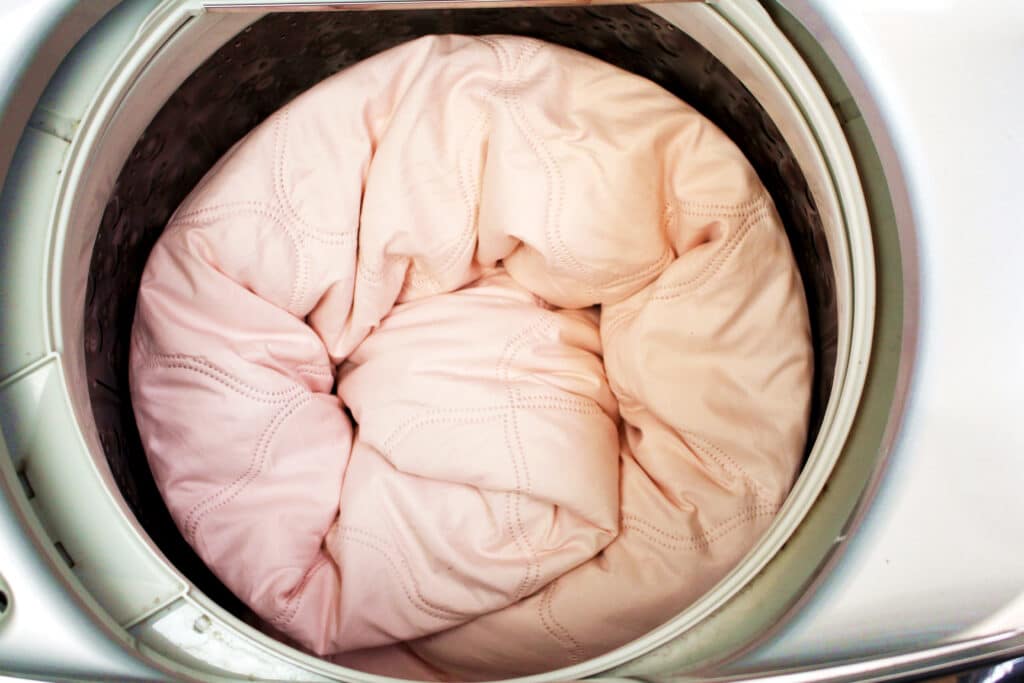
Jackets, coats, and heavy outerwear
Puffy coats and durable gear: For winter jackets, coats, and other heavy outerwear, the choice between heavy duty and bulky depends on the item. If you have a thick down parka or a fluffy insulated coat, treat it like bedding – the bulky cycle is usually best. Bulky will ensure the coat gets fully wet and gently cleaned without agitating the filling too harshly. It also helps prevent any lining or insulation from getting distorted. However, if you’re dealing with a rugged work coat or a washable heavy coat that’s caked in dirt or oil (imagine a mechanic’s jacket), the heavy duty cycle might be warranted for the deep cleaning power. Just make sure the item can handle the rougher treatment and isn’t so large that it will throw the machine off balance.
When in doubt, size wins: A good rule of thumb is to default to the bulky cycle for any item that is physically large or thick, unless it’s exceptionally grimy and tough. For example, a lightly dirty sleeping bag should go on bulky to protect its filling, whereas a small but filthy shop rag would go on heavy duty. If an item is both bulky and very soiled (say a mud-covered comforter), you might need to do a two-step: run a bulky cycle first to get it fully soaked and rinsed, then a heavy duty cycle (perhaps in a large machine) for a second pass at remaining dirt. Or better yet, let a professional handle it – our team can assess the item and use the optimal process so you don’t have to experiment.

Cycle mechanics: agitation, water levels, spin speed, and time
Now let’s demystify how these cycles actually work under the hood. The differences come down to four factors: how the washer agitates (moves clothes around), how much water it uses, how fast it spins, and how long the cycle runs.
Agitation: The heavy duty cycle uses vigorous agitation. In a top-loader, that means an aggressive back-and-forth or twisting motion; in a front-loader, it means more frequent and forceful drum rotations. This strong motion scrubs dirt out of fabrics, but it can be rough on gentle fibers. The bulky cycle uses slower, gentler agitation – often a swaying or slow tumbling motion. This is just enough to circulate water through a big comforter without beating it up. Gentle agitation prevents large items from getting tangled or stretched out. You’ll notice bulky cycles sometimes pause during the wash to let heavy items soak longer, whereas heavy duty just powers through with constant movement.
Water level: Most heavy duty cycles use more water than a normal cycle, but they may not always fill the tub to the very top. The idea is to have enough water to flush away heavy soil. The bulky cycle, however, typically maxes out the water level. For example, Whirlpool’s own washer guide advises that you “always select the Bulky cycle when washing large items or heavy items” – including comforters, heavy coats, sheets, and bedding. All that water is key to ensuring a big item gets wet inside and out. It also adds extra weight to help push the item against the agitator or drum for cleaning. If you peek into your washer during a bulky cycle, you’ll likely see your quilt floating in a deep pool of water – that’s by design.
Spin speed: Heavy duty cycles tend to use a fast spin (high RPM) at the end. A speedy spin wicks more water out of heavy fabrics like denim or terrycloth, which shortens drying time. Bulky items cycles usually go with a slower spin. A sleeping bag or comforter holds a ton of water, and spinning it too fast can make the machine shake or could even damage the item by centrifugal force. Manufacturers often limit bulky cycles to a medium spin – enough to extract some water, but gentle enough to keep the load balanced. Don’t be surprised if your blankets come out of a bulky cycle still a bit damp; that’s preferable to risking a violent spin-out.
Cycle time: Heavy duty is one of the longest cycles on washers. It might run 60 to 120 minutes depending on the model, because it often includes longer wash times and extra rinse phases to handle heavy soil. Bulky cycles can also be lengthy (large items need more time to soak and rinse), but sometimes they’re a tad shorter than heavy duty in total runtime. The key difference is where that time is spent: heavy duty spends more time actively agitating and scrubbing, while bulky spends more time soaking and slowly tumbling. Either way, both cycles take longer than your normal wash. That’s another reason to reserve them for loads that truly need it – otherwise you’re spending extra time (and energy) on an oversized cycle for no benefit.
Overlapping use cases and common misconceptions
It’s easy to mix up these two settings, so let’s clear up a few misconceptions we often hear from customers:
- “Bulky and heavy duty are basically the same.” Not exactly. They might both use more water and time than a normal cycle, but the way they wash is different. Heavy duty is harsher (meant for dirt), bulky is gentler (meant for size). Using heavy duty when you really needed bulky (say, for a comforter) could result in an unbalanced load or ripped fabric. Using bulky when you needed heavy duty (say, for greasy overalls) might leave some grime behind. It pays to match the cycle to the situation.
- “Use heavy duty for large loads of regular clothes.” Not necessary. If you just have a big load of everyday T-shirts and pants, you don’t need heavy duty unless they’re truly filthy. “Heavy duty” doesn’t mean “more clothes at once” – it refers to soil level and fabric weight. For large loads that aren’t especially dirty, you’re better off splitting into two normal loads or using a high-capacity washer on normal cycle. Save heavy duty for when the clothes really need that extra punch.
- “Always use bulky for towels and linens.” Depends on soil and size. A few towels or a set of sheets will clean up fine on a normal or heavy duty cycle, depending on how dirty they are. You’d use bulky if you’re washing many towels at once or an oversized blanket that fills the machine. Don’t feel like you can’t wash bedding on heavy duty, though – some washers actually combine “Bulky/Sheets” into one cycle, and others suggest heavy duty for things like bed sheets or heavily soiled towels. When cycles overlap, default to the item’s needs: delicate or huge items lean toward bulky, dirty and sturdy items lean toward heavy duty.
- “My washer will automatically use enough water.” Not in every cycle. Eco-friendly machines try to use less water on normal and quick cycles. That’s why using the bulky cycle for a puffy item is important – it overrides the eco sensors and fills up to ensure saturation. Similarly, heavy duty cycles might override some energy-saving features to use hot water or extra rinses. So if you’ve ever been disappointed peeking through the lid expecting lots of water, it might be because you weren’t on bulky or heavy duty when you should have been.
Another overlapping scenario is capacity limits. Extremely heavy or bulky items (like a large rug or an overstuffed king comforter) might exceed what your home washer can handle, even on the right cycle. It’s not a failing of the cycle – some things are just better suited to commercial-grade machines. Rather than risking a burnt-out motor, consider using a larger washer at a laundromat or scheduling a pickup with us for those tricky items. We have plenty of experience with the oddballs: from oversized pet beds to piles of construction uniforms caked in mud, our team will choose the best approach (we have all the cycles at our disposal) and even take care to use the proper detergents and water temperatures for optimal results.
Choose the right cycle and save time (or let us handle it)
Mastering your washer’s heavy duty and bulky cycles can make a real difference in your laundry routine. By using the correct setting, you’ll avoid unnecessary wear on your clothes and your machine – and you won’t have to run a load twice because it came out still dirty or soapy. That’s time back in your week. Considering Americans already spend about 4 to 5 hours a week doing laundry, every saved minute counts. As a neighbor-approved laundry service, we love helping customers reclaim some of that time.
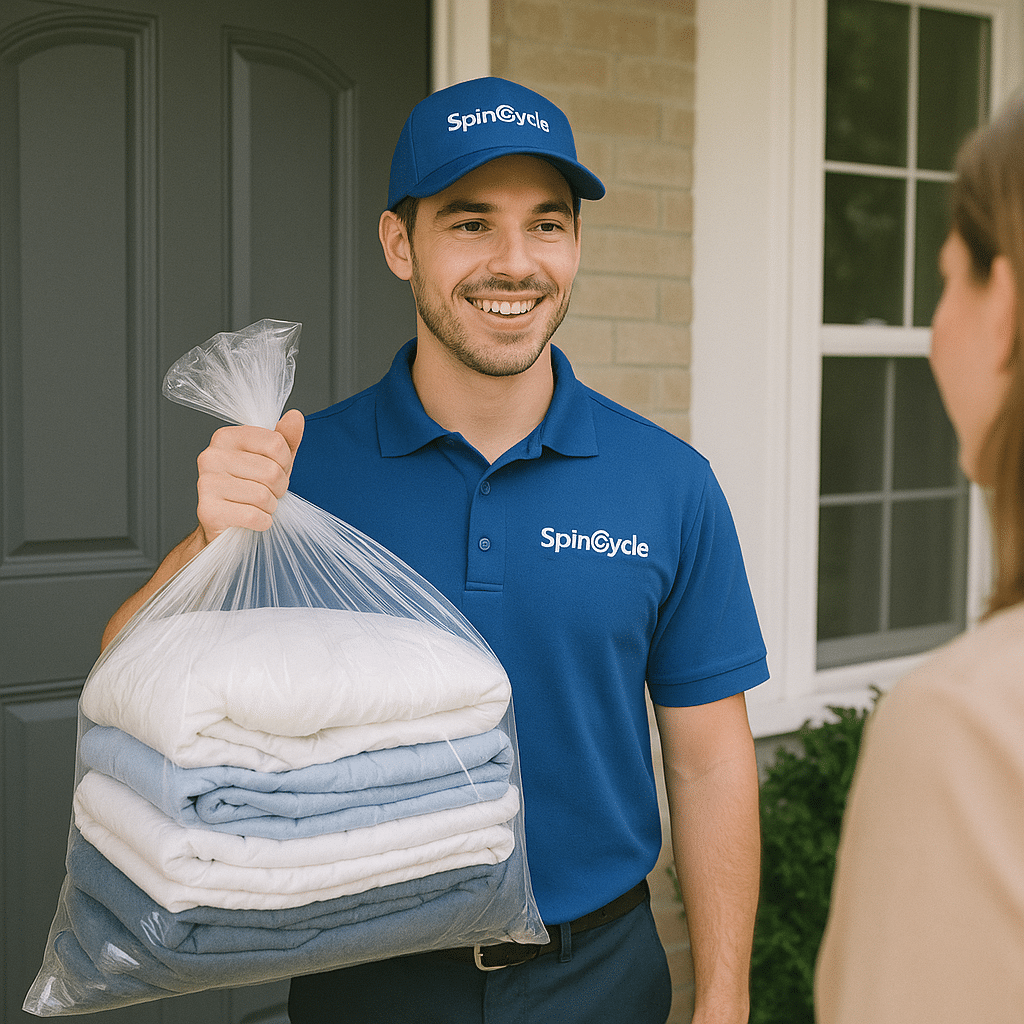
Remember, heavy duty vs bulky isn’t about which is “better” – it’s about using the right tool for the job. Treat your clothes kindly by washing them in the appropriate cycle, and they’ll reward you by looking better and lasting longer. And when a load is too large, too dirty, or just too much to deal with, you have backup. You can always book a pickup and let Spincycle’s team do the heavy lifting. We’ll wash and dry your items in the ideal cycles (our high-capacity washers can handle anything), so you get fresh, neatly folded laundry without the headache. It’s like having a laundry expert neighbor who can take over when you need a break.
In the end, knowing the difference between heavy duty and bulky cycles means less guesswork and more peace of mind on laundry day. Your towels will be fluffier, your comforters cleaner, and your schedule a little freer. If you’re curious about other settings your washer offers, feel free to check out our washing machine cycles guide for a deeper dive. Until then, happy washing – and remember, when in doubt, we’re just around the corner to help keep your laundry pile under control.




